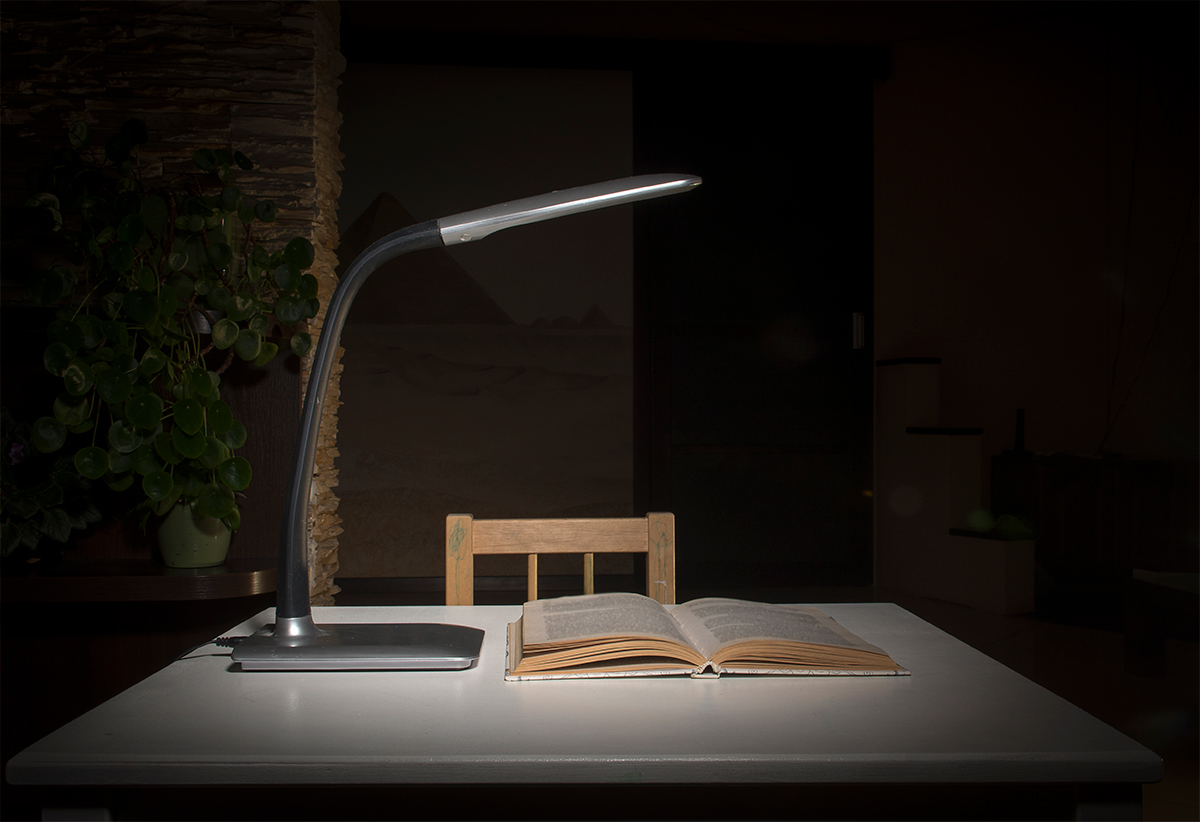General description
A desk lamp is a portable, positionable task light that is used to provide localized illumination of activities taking place on desks, tables and workstations. Task lights of this type are challenged with providing sufficient, uniformly distributed illuminance over the entire area that needs to be illuminated, while keeping from excessive luminances and high contrasts that can be visually fatiguing or become uncomfortable sources of glare.
In order to create effective fields of view where there are sustained or high concentration visual tasks, localized task lighting imposes the need for desk lamps to incorporate two essential characteristics: functionality and flexibility.
Desk lamps may be used to illuminate a variety of tasks such as reading, writing, drafting, crafting, knitting, and painting, and computer work. Selection of desk lamps requires an awareness of quantitative and qualitative requirements of the tasks to be performed. Among these requirements are illuminance levels, photometric distribution, uniformity ratio and color quality. In addition to fulfilling the quantitative and qualitative requirements, a desk lamp needs to deliver ergonomics and controllability that make lighting flexibly adaptable to personal needs.
LED technology sits at the very heart of today’s task lighting systems
Over the past decade solid state lighting (SSL) based on light emitting diode (LED) technology has been established as the mainstream choice for almost all lighting applications. When it comes to desktop task lighting, the transition to LED technology brings a whole new world of design possibilities, results in the ever-expanding boundary of lighting performance, and offers the opportunity to move past the legacy functionality of providing basic illumination.
LEDs are semiconductor emitters that generate light through intracrystalline recombination of charge carriers (electrons and holes) which are injected with an appropriate current at a forward directional voltage. In addition to the advantages of high efficiency, long service life, reliable operation, absence of UV radiation and solid state durability, LED lighting delivers a host of new capabilities not available in their predecessors.
The ability to engineer the spectral power distribution (SPD) of the light source enables desk lamps to deliver light that supports high visual performance and engage specific physiological and psychological responses for a positive effect on human health.
The LED technology platform provides the chance to build sensors, microprocessors, communication ICs into luminaires for deploying sophisticated lighting control algorithms, which opens the door to a wide range of innovative functionalities and compelling value propositions.
The miniature scale or compactness of LEDs makes it possible to advance beyond legacy form factors and create products with a perfect fusion between form and function.
Creating an LED desk lamp is a complex exercise
The key to unlocking the full potential of LED lighting is to have LEDs and other constitutive parts all integrated into a single system. The holistic approach to design and engineering is intended to address the challenges of LED operation which is interdependent upon the thermal, optical, and electrical system applied. LED desk lamps are available with a fixture-plus-bulb configuration. However, the quality of light, efficacy and life are often compromised in LED bulbs which are inherently deficient in the capacity to accommodate high-performing thermal management systems and driver circuitry. The critical photometric performance is affected by the native light distribution characteristics of a light bulb.
The fundamental design philosophy of today’s products is to integrate the LED source with a high capacity thermal management system, an optical system tailored to the task lighting application, and full-featured driver and control electronics. All components work in unison to deliver the intended value, which is reflected in the achievement of the required form factor as well as high photometric performance, system efficiency and reliability.
A holistic approach to system integration
An LED desk lamp hereinafter refers to an integrated LED system. The lamp head, which houses the LEDs, may be fixed with its support arm and stand but more often than not is adjustably mounted on a gooseneck or an articulated arm to provide the flexibility of optical aiming. It incorporates an LED module, optics and a heat sink. Most lamp heads have a full aluminum construction in which the heat sink and housing may be formed of thermally conductive aluminum as one piece to maximize convective heat transfer.
An LED module is an assembly of LEDs on a metal core printed circuit board (MCPCB) or simply an integrated LED array which is designed for direct integration with the heat sink. The LED module is mounted to the heat sink, sometimes via a thermal interface material (TIM) which is used to minimize the interfacial contact resistance, to create a thermal path that allows heat extraction from the LEDs to the ambient environment to take place.
To achieve typical product characteristics with respect to lifetime (defined by lumen maintenance) and color stability, it is crucial to ensure that the LEDs operates within their specified temperature limits. LED desk lamps draw a total of less than 10 watts of electrical power. While low-wattage operation does not create a high thermal load, the thermal path of an LED desk lamp should still be adequately designed because the LEDs incorporated in the product are usually plastic packages. Poor thermal dissipation can cause excessive heat buildup within the semiconductor package, leading to thermal degradation of packaging materials.
Optical design
The optical system is a key component that goes into the design of an LED desk lamp. Desk lamps, because they are located closer to the task plane than overhead fixtures, are a considerably more effective in delivering light from the source to the task. However, this type of lighting deployment can be a two-edged sword.
As the light source gets close, its luminance increases. LEDs are high flux density devices that produce a large amount of lumen from small chips. This optical characteristic presents an extra design challenge. The concentrated lumens must be distributed on a larger surface in order to achieve uniform light distribution for optimal task visibility and create an acceptable luminance which is not disturbing to the user. Light reaching the eye directly from an LED or indirectly from a reflective surface illuminated by a bright LED causes glare when the luminance ratio in relation to the state of adaptation is excessively high.
Depending on the luminance and size of the glare source, visual disability (a reduction in visual capabilities) or visual discomfort (without necessarily affecting the ability to see) can be expected. Besides the luminance ratio, the uniformity of light distribution also affects task visibility. The average-to-minimum illuminance ratio over the practical task plane should be as low as possible and never exceed 1.4:1.
Luminance and light distribution
To achieve high uniformity and visually comfortable lighting, luminous flux from the light source of LED desk lamps is fully regulated. Depending on the optical architecture the lamp heads of LED desk lamps are basically divided into two groups: backlit and edge-lit. A backlit LED lamp head is a direct lighting assembly in which the LEDs emit toward the task through an opal diffuser or a lens that is molded with a diffusion mechanism. The LED module is typically a one-piece assembly of discrete SMD LEDs. The optical architecture of this type is simple to implement but can come up with visible LEDs, hotspots or shadows if there’s insufficient optical setback or inadequate light diffusion. Chip-on-board (COB) LEDs with their key advantage lying in the uniformity of the light emission also have a foothold in backlit LED desk lamps.
An edge-lit LED lamp head employs a light guide panel (LGP) to transport light produced by side-emitting LED modules through total internal reflection (TIR). The LGP has optical channels which refract light downwards and evenly distribute light across the diffuser. This approach creates a homogeneous luminous surface with soft luminance and delivers highly uniform desktop illuminance.
Light source
The LED package selection defines many product variants of a desk lamp. The radiative recombination of the charge carriers in the active region of a diode (LED chip) produces light with a narrow spectral width, which means that LEDs are inherently monochromatic light sources that emit single-color light. To produce white light with LED chips, the narrow spectrum must be shifted and/or spread in wavelength. By far most of the commercially available white LEDs employ the phosphor-converted LED (PC-LED) architecture.
A phosphor-converted LED package combines a GaN-based LED with down-converting phosphors which partially or completely converts the electroluminescence to obtain white light. Typically, blue LED chips are used to pump phosphors within the device package. In blue-pump LEDs, only part of the emitted light is converted to longer wavelengths. The down-converted longer wavelength light then mixes with blue photons that escape from the phosphor layer without going through wavelength conversion to deliver the required spectrum. When compared with full conversion that is used by violet-pump LEDs, partial conversion has a fundamentally higher efficiency because the Stokes shift is usually small. As a result, blue-pump LEDs deliver a much higher efficacy which in turn makes them the logical choice for lighting applications.
Color rendering
The PC-LED architecture, however, comes with a tradeoff between luminous efficacy and color quality. Task lighting often places high demand on the ability of a light source to accurately render the colors of the objects. To deliver high color rendering lighting, the light source must deliver balanced amounts of radiant power in different parts of the visible spectrum. The better balanced a light spectrum is, the more the amount of short wavelength light needs to be down-converted, and consequently the lower the luminous efficacy. When evaluating a product, the color rendering property should be thoughtfully balanced with the efficacy.
The color rendering index (CRI) of LED desk lamps can range from 80 up to 95. Products intended for color-critical applications should use LEDs with a minimum CRI of 90 and a minimum R9 of 25. R9, which is not included eight standard color samples for calculation of CRI, shows the response with deep reds. Blue-pump LEDs usually have a distinct blue peak in their SPD and do not distribute radiant power uniformly across the visible spectrum. Where color rendition is of critical importance, violet-pump LEDs should be seriously considered. These LEDs use red, green and blue phosphors to convert all primary radiation from the violet LED chips, resulting a balanced spectrum that supports faithful color reproduction.
Color temperature
The distribution of radiant energy emitted at the different wavelengths of the visible spectrum also determines how the light appears. An LED can be characterized by its correlated color temperature (CCT) which relates to the color of light. Promoting alertness, creativity and productivity while also reinforcing the impression of an unwinding atmosphere and pleasantness, neutral white light which exhibits a CCT in the 3500K to 4100K is most conducive to creating visual conditions that allow people to work or study in a concentrated way at desks. Warm white light which exhibits a CCT between 2700K and 3200K range has more radiant power the longer (red) wavelengths, while cool white light has more radiant power the shorter (blue) wavelengths and exhibits a CCT greater than 4100K.
While there may be culture or climate related preferences for warm or cool light, extra caution should be exercised on the non-visual biological effects of light on the human body and the photobiological aspect of lighting. Exposure to blue-intensive light during the night can disrupt circadian rhythms and causes health risks. Light sources with a CCT above 5000K should be carefully used for nighttime tasks because of the high percentage of biologically effective blue contained in their spectrums. The trend of serving flexible task lighting is ongoing. With LED technology, the SPD of the light emitted by a desk lamp can be actively controlled to create different combinations of wavelengths that exhibit different CCTs. Tunable white LED desk lamps which mix LEDs with different CCTs in one module bring flexibility to change the color of light from warm to neutral to cool in appearance. These products allow task lighting to be aligned with circadian rhythms as well as key activities that require people be more focused, alert, active, or relaxed, for instance.
Blue light hazard (BLH)
Exposure to blue-enriched high CCT light has also been implicated to cause retinal damage, which is known as blue light hazard (BLH). At a high enough intensity and color temperature, all light sources have the potential to cause irreversible, oxidative damage to retinal cells (up to blindness). This is why the use of light sources with a CCT above 5000K for task lighting is not advocated, in particular when the user is a young child whose eye cannot efficiently filter blue light or who has not yet developed aversion responses.
LEDs were not found to pose a greater risk than other sources having the same CCT. Because most white LEDs are blue-pumped and have a distinct blue peak in their SPD, LED lighting can be easily misinterpreted as posing photobiological hazard. The amounts of blue light (400–500 nm) in different light sources having the same CCT have no significant difference. The issue with LED lighting in this regard is that LEDs are high flux density sources.
Exposure to directly visible LEDs that are intense in lumen output contributes to the risk potential. LED desk lamps with naked, high CCT LEDs are generally assigned to Risk Group 1 (RG1: low risk) or Risk Group 2 (RG2: moderate risk). This is where thoughtful optical design makes sense. With proper optical regulation that minimizes luminance and ensures no direct view of the naked LEDs, LED desk lamps can be very safe to use (Risk Group 0).
LED driving and dimming
An LED desk lamp needs to be operated by a constant current LED driver that is capable of providing tightly regulated direct current to drive the LED load. The LED driver usually accommodates an AC input and implements a switched-mode DC-to-DC converter to regulate the output. It is important to make an LED driver which generates minimal ripples in the output current. The output current ripple is the residual periodic variation of the DC voltage resulting from incomplete suppression of the alternating waveform within the power supply. High current ripple leads to visible or invisible flicker which can strain the human eyes, trigger symptoms such as headaches and migraines, and even cause serious epileptic seizures in certain populations. This ripple needs to be sufficiently low (within ±5%) so as not to develop high and low frequency flicker.
It is often desirable to implement task lighting with a step or continuous dimming functionality to provide variable light output. Incompatible interaction between the dimmer or dimming circuits and the switch mode power supply (SMPS) can also result in large ripples in the DC current.










Loading...